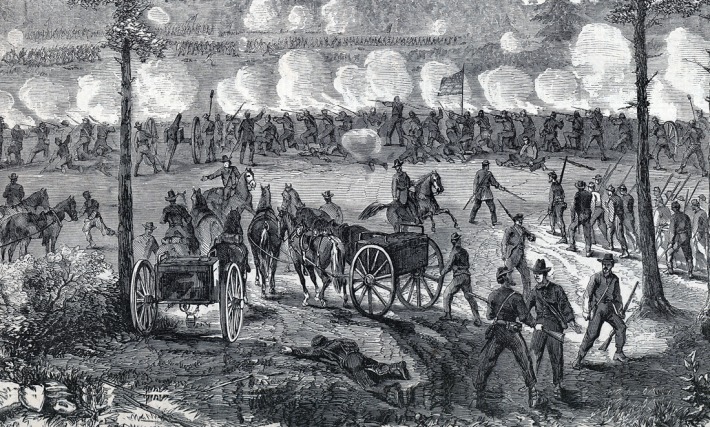H/T RebelGrey57
(Picture: Artist’s impression of battle from Union lines)
Aug. 25, 1864- The 2nd Battle of Reams Station
Soon after the Union success at the battle of Weldon Railroad, Gen. Winfield Scott Hancock’s (USA) II Corps was ordered to move south along that rail line, destroying it as it went. The intent was to stretch even further the distance by which Gen. Robert E. Lee (CSA) had to move his supplies.
By late August 24 the II Corps had worked its way three miles south of Reams Station. Hancock was informed that Gen. A.P. Hill’s (CSA) infantry and Gen. Hampton’s (CSA) cavalry were moving out of Petersburg’s defenses to meet this threat.
During the morning Hampton had been driving the Union north, back up the Halifax Road towards Reams Station. Meanwhile, Hill’s attacks from the west in the early afternoon had only taken some outlying trenches from the Union.
Around 2:00 pm he launched an attack on the main breastworks which fell apart quickly. Since Hill and Hampton failed to coordinate their attacks and the element of surprise had been lost, Hill determined that a large frontal assault was needed to drive the Union forces off the railroad.
It was 5:00 pm before the Confederates are ready for their second assault and it began with a heavy barrage from the artillery.
The II Corps was quickly overrun and the amount of unguarded Union prisoners sent back was so large that the Confederate command momentarily believed, due to the smoke and confusion, that their attack was a failure and that those were their men coming back.
By 6:00 pm the assault had lost its momentum and in return Hancock reminded the Confederates why he was a worthy adversary.
Regrouping the II Corps he sent his men back down the lost trenches and across the field to Oak Grove Church. Initially successful, the counterattack failed. In the midst of this Hancock told a staff officer, “Colonel, I do not care to die, but I pray to God I may never leave this field!”
Hampton and Hill are finally able to coordinate an attack upon the Union position and under this pressure the II Corps was swept from the field by 7:00 pm.
In Hill’s triumph, Hancock realized his greatest defeat as a corps commander, losing nearly 3,000 soldiers as casualties or as prisoners. Though Hancock would have some measure of success at Burgess Mill he never quite recovered from Reams Station and relinquished command of the II Corps by Thanksgiving of that year.
The victory at Reams Station meant Lee, though unable to force the Union off the Weldon Railroad completely, had minimized further damage to the rail and had kept most of his supply line intact.


